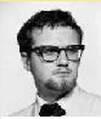|
Prince Charles explains 'pebble theatre'.
|
PEBBLE
|
|
Don Pierson [right] explains how a young Prince Charles made a request to join the Radio London fan club. |
|
|
Prince Charles explains 'pebble theatre'.
|
PEBBLE
|
|
Don Pierson [right] explains how a young Prince Charles made a request to join the Radio London fan club. |
|
|
This is a companion to our feature about Radio Nord. The Skagerrak seaway connects to the Kattegat and serves as the gateway from to the North Sea into the Baltic Sea. Its shoreline touches southeast Norway; the west coast of Sweden and the Jutland peninsula of Demark. The Polaris nuclear missiles had a limited range, and this is one reason why a US Navy nuclear submarine from its maintenance base at Holy Loch in Scotland, was placed on station in this area. It could effectively prevent the USSR fleet from exiting the Baltic Sea into the North Sea. Note the U.S. military presence in the area with Polaris nuclear missiles on board nuclear submarines and nuclear tipped Nike-Hercules missiles, all standing guard around 'neutral' Sweden which was surrounded by U.S. interests on board the Danish and Swedish Radio Mercur operations close to Malmo, Sweden, and Radio Nord off Stockholm, Sweden. Nils-Eric Svensson who bought time on Radio Mercur to start a Swedish version, took off for Pasadena, California in this same time period. Now notice this old autobiographical entry by Herbert W. Armstrong from Pasadena, California: "Now we come to the year 1959. .... Garner Ted and I boarded an SAS (Scandinavian Airlines System) polar-flight DC-7 plane at Los Angeles International Airport, in early June, 1959 .... We arrived in Copenhagen about 3 o’clock in the morning. .... First Ship Radio Station .... This was our first visit to one of the Scandinavian countries. We took this flight, stopping first at Copenhagen, because we wanted to contact the first radio station that we had heard of operating offshore from a ship. The offices of this station were in Copenhagen. .... I was not able to contact the manager of the station, who was out of town. However, I did contact him later by telephone. Nothing definite came of it at the time, but it did open to our investigation the idea of broadcasting from offshore ship stations, to countries where no radio time can be purchased or used by The World Tomorrow. .... We carried with us a portable Ampex tape recorder. In fact it was the first of the Ampex 600 models -- I believe ours was the first set from the factory. This was the first portable tape recorder that was of professional broadcast quality, so that programs recorded on it would be acceptable for broadcast by the largest, most discriminating radio stations."  At that time Nils-Eric Svensson [left] was a very young person and he seems to have been the 'front' for others in much the same way that Ronan O'Rahilly was later used in a similar role during the 1964 launch of 'Radio Caroline'. Because when peering behind the curtain of 'Radio Nord', we don't just find some Americans assisting a Swedish guy and his staff, we find a completely American dominated operation. Again, the O'Rahilly 'smoke-screen factor' is brought into play to conceal what is really going on, because the manager of 'Radio Mercur' was also a U.S. citizen with a broadcasting background, and a future with the 'Voice of America'. Tomorrow, we will introduce you to the American manager of 'Radio Mercur' that Herbert W. Armstrong came to meet! Comments are closed.
|
Our team produced this free radio program for PCRL in Birmingham.
It was repeatedly broadcast on and after October 20, 1985. Click & listen! Blog Archive
August 2023
Copyright 2021 with all rights reserved.
|
Index |
Library |
|
